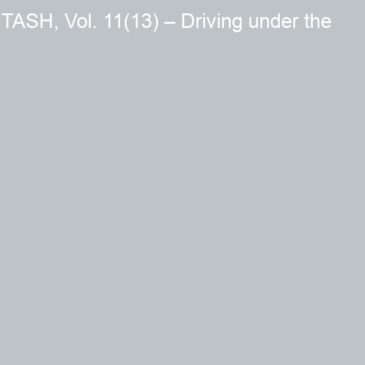Editor’s Note: This post was written by Luke Downey, PhD, Senior Research Fellow in the Centre for Human Psychopharmacology, Swinburne University of Technology. Dr. Downey recently completed the Division on Addiction Visiting Scholars Program.
Although most drivers recognize the dangers and laws against driving under the influence (DUI) of alcohol, the dangers and prevalence of DUI of other prescription based psychoactive medicines are less well known. Nonetheless, it is possible that those who engaged in risky behaviour, such as DUI, also might engage in other risky behaviour, such as risky drug use. This issue of STASH explores the use of psychoactive prescription drugs among persons suspected of DUI (Karjalainen et al., 2015), as part of our Special Series on Driving Under the Influence.
Methods
- Researchers conducted secondary analyses of the Finnish National Prescription Register and Register of DUI suspects, which includes all persons arrested and suspected of DUI by the police.
- For the analyses, the researchers considered data from people suspected of DUI between 1995 and 2005 (n = 29,470 drawn from the Register of DUI suspects), and an age- and gender-matched reference population (n = 30,043 drawn from the Finnish general population).
- DUI suspects included four primary types based upon substances found in their blood/urine samples during their first arrest: alcohol only (DUIA, n = 27,861); prescription drugs only (DUIP, n = 402); alcohol and prescription drugs (DUIAP, n = 335); and illicit drugs (DUID, n = 872).1
- The researchers used the registry data to identify whether each participant had purchased a prescription drug with abuse potential (e.g., benzodiazepines, opioid agonists).
- The authors explored the relationship between DUI and prescription drug purchases using mixed-effects logistic regression.
Results
- The use of psychoactive prescription drugs and DUI appeared to be strongly associated. Each type of DUI suspect was more likely to have purchased abusable prescription drugs, overall, and benzodiazepines, specifically as compared to non-suspects.
- For example, the DUIP type was 49.6 times more likely to purchase abusable drugs, and 20.9 times more likely to purchase benzodiazepines than non-DUI comparators. See Table 1.
- DUI types DUIAP and DUID also were more likely than non-DUI comparators to have purchased opioid analgesics.
| DUI (n = 29,470) |
Reference population (n = 30,043) |
DUIA (n = 27,861) |
DUIP (n = 402) |
DUIAP (n = 335) |
DUID (n = 872) |
|
| Purchases(%) | ||||||
| All abusable drugs2 | 26.0 | 12.9 | 23.7 | 77.1 | 76.7 | 55.7 |
| Benzodiazepines3 | 20.9 | 8.4 | 18.5 | 73.4 | 74.3 | 52.9 |
| Opioid analgesics | 9.4 | 5.8 | 8.7 | 22.9 | 23.3 | 18.5 |
Figure. Purchases of Psychoactive Prescription Drugs among DUI groups and the general population (Adapted from Karjalainen et al., 2015).
Limitations
- DUI suspects in this study do not represent all the drunk/drugged driver population in the traffic flow, since they were suspected and arrested by the police, and not all people driving under the influence are apprehended.
- The National Prescription Register does not cover all drugs purchased, only those that are reimbursed, and people abusing medicines or using them for non-medical purposes may not always seek reimbursement for fear of exposing their aberrant drug usage.
- The study relied upon data from one country, Finland, whose drug usage patterns may differ from other countries.
Conclusions
From the data presented, it appears that suspects in all DUI groups were more likely to use psychoactive prescription drugs (all abusable drugs, benzodiazepines, and opioid analgesics) when compared to the reference population. Substance abuse problems among arrested drunk/drugged drivers should be evaluated, and DUI offenders should be referred to treatment if considered appropriate. In addition to legislative measures, interventions on the individual level should be prioritized in order to reduce DUI and reduce harm to the public.
— Luke Downey
What do you think? Please use the comment link below to provide feedback on this article.
Reference
Karjalainen, K., Haukka, J., Lintonen, T., Joukamaa, M., & Lillsunde, P. (2015). The use of psychoactive prescription drugs among DUI suspects. Drug and alcohol dependence, 155, 215-221.
________________
[1] This group may have had findings for alcohol and/or prescription drugs, too.
[2] Includes purchases of either benzodiazepines, opioid analgesics, hypnotics, methadone, methylphenidate, or pregabalin.
[3] Includes also benzodiazepine related drugs acting on a similar receptors as benzodiazepines (e.g., zolpidem, zaleplon, zopiclone).




